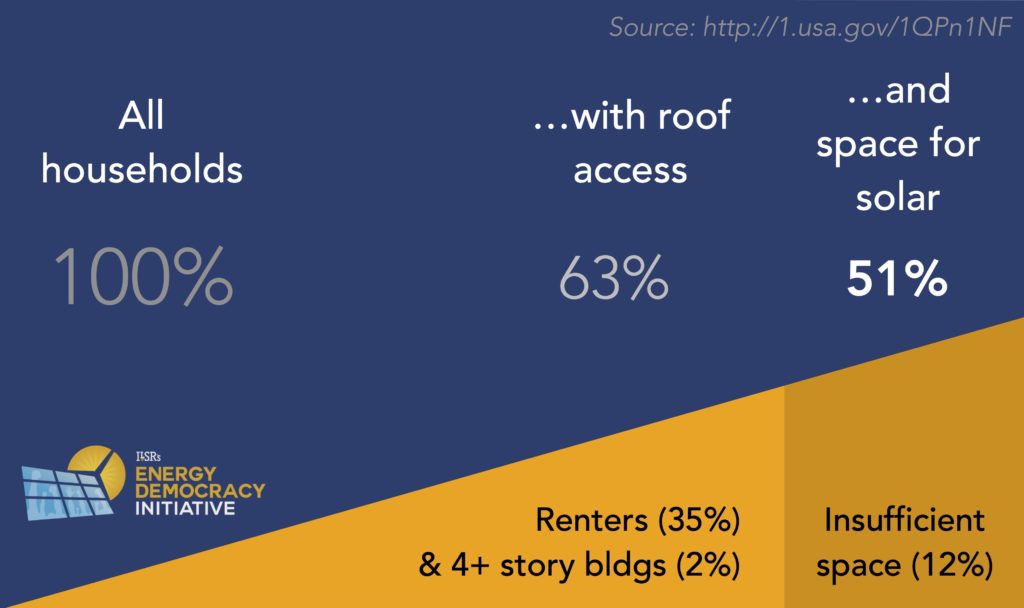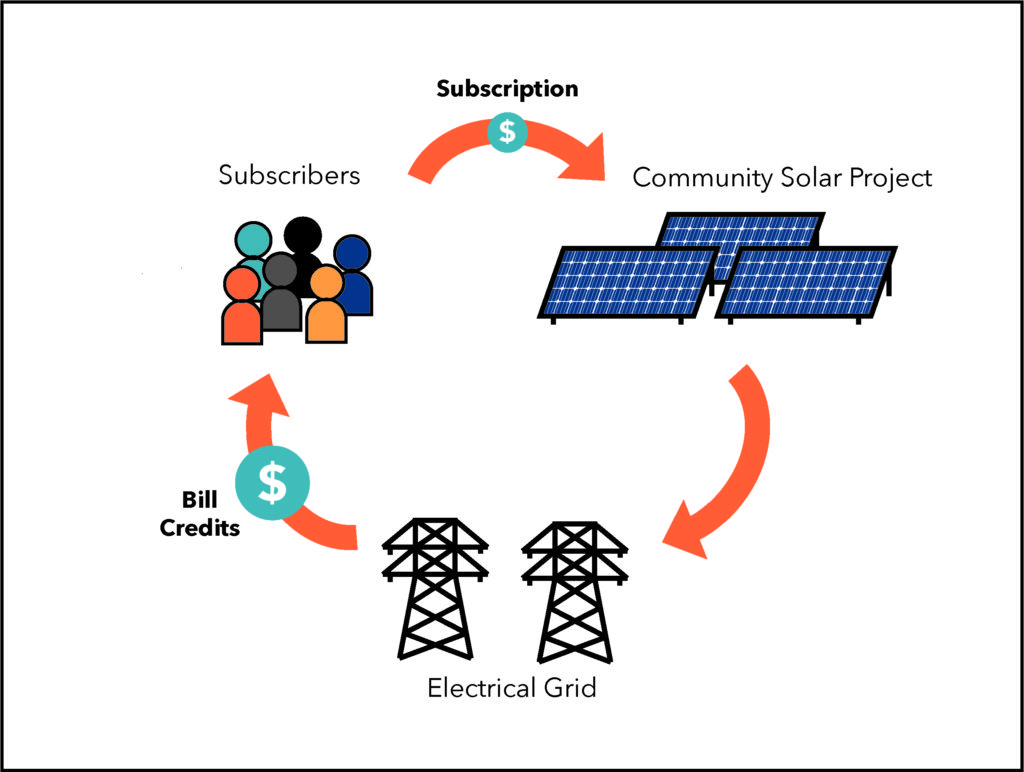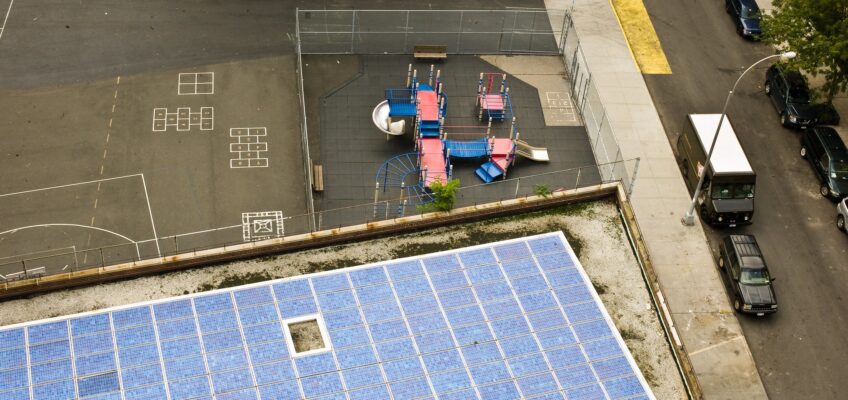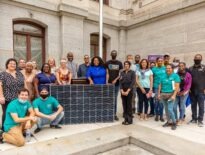Updated Quarterly
![]()
How are Community Solar Garden programs doing across the country?
For decades, rooftop solar has allowed homeowners to generate their own renewable electricity — reducing their dependence on monopoly utilities and lowering their energy bills. However, solar rooftops are not a viable option for many people. What about those who can’t afford one? What about renters? Plus, only a portion of buildings have roofs that are large enough, facing the right direction, and sunny enough for solar.

Community solar picks up where traditional rooftop solar fails.
Through community solar, individuals subscribe to a portion of a nearby solar garden and get credits on their energy bill for the electricity it produces. This way, people without the financial means for solar on their rooftops and people who don’t own suitable rooftops can still reap the benefits of renewable energy. Local governments and installers can go even further to include subscribers with poor credit, or use local installers on the project.

Community solar can and has been installed on places of worship, in brownfields, and over parking lots.
For more details on the benefits of community solar, see this report from Vote Solar, MnSEIA, and the Institute for Local Self-Reliance.
We report on Minnesota’s community solar program every month in this blog post, but community solar is gaining traction in other states, too. Community solar can happen in any state sharing two key market characteristics: virtual net metering and requirements for utilities to connect distributed solar to the grid (interconnection rules). Community solar program legislation can include both elements.
20 states have passed legislation supporting community shared solar gardens, but few have active programs with a significant number of interconnected gardens. ILSR will update this post quarterly with the number of projects and megawatts of installed capacity in states with a formal community solar program that allows non-utility ownership. ILSR tracks states with the largest community solar programs and states with accessible and regularly updated datasets.
Although rural electric cooperatives have built a significant amount of community solar, many of the programs do not allow non-utility ownership and may differ from state-based programs that are structured to provide bill savings to customers.
Colorado
After a successful pilot program in 2010, Colorado finally saw an expanded community solar garden program in 2016. The program still has a cap of 105 MW, a figure grown out of Xcel’s settlement deal. The Colorado community solar program has always had a goal of inclusivity. Since the 2010 pilot, the program has had a 5% carveout for low-income customers. Now, advocates hope this percentage can be dramatically increased as the state continues to update the program.
At the end of 2021, Colorado’s community solar program hit 102 completed projects with 130 total megawatts of operational capacity. Xcel Energy reports on Colorado’s community solar program in its annual Renewable Energy Compliance reports.
![]()
Illinois
In 2016, the Illinois Legislature passed the groundbreaking Future Energy Jobs Act (FEJA) with bipartisan support. The legislation includes the Adjustable Block Program, which makes solar energy more accessible to low and moderate income communities through community solar projects, rooftop solar, and brownfield solar. The adjustable block program is a state-administered solar incentive program facilitating new photovoltaic distributed generation development and community solar projects through the issuance of renewable energy credits provided in the first 15 years of operation. A “block” is a pre-established amount of capacity available for a certain type of project with set REC prices.
In the first quarter of 2023, Illinois’s community solar program hit 107 completed projects with 207 total megawatts of operational capacity.
![]()
Massachusetts
Although the Massachusetts Senate passed a virtual net metering bill in 2008, its first true community solar project went online in 2014. Massachusetts tracks and credits community solar gardens through two Massachusetts Department of Energy Resources programs: RPS Solar Carve-out II (phased out in 2020) and Solar Massachusetts Renewable Target (SMART).
In the first quarter of 2023, Massachusetts’s community solar program hit 478 completed projects with 816 total megawatts of operational capacity.
![]()
Maryland
Maryland’s community solar pilot program, established in 2017, is split among four investor-owned electric utilities. This chart displays the installed capacity in three: Baltimore Gas & Electric, Delmarva P&L, and Pepco. Data from Potomac Edison/First Energy is not complete enough for publication.
At the end of 2022, or pilot year five, Maryland’s community solar pilot hit 88 megawatts of operational capacity.
![]()
Minnesota
Minnesota’s community solar program launched in December of 2014, with the first full megawatt of projects installed in January 2017. The program has since taken off to become one of the most successful in the country. The success of the program in Minnesota can largely be attributed to its design, which places no caps on community solar project development. It is also carefully constructed to make solar economically viable. According to ILSR’s analysis, the program has saved Xcel Energy customers millions of dollars.
In the first quarter of 2023, Minnesota’s community solar program hit 467 completed projects with 869 total megawatts of operational capacity.
![]()
New Jersey
In 2021, New Jersey formalized its community solar program after two years of testing a community solar pilot. The New Jersey Board of Public Utilities accepted stakeholder feedback in early 2022 to finalize the program rules. New Jersey’s clean energy program reports on the state’s solar and community solar pipeline every month.
In the first quarter of 2023, New Jersey’s community solar program 25 completed projects with 48 total megawatts of operational capacity.
![]()
New York
In 2017, New York’s Public Service Commission passed the Value of Distributed Energy Resources (VDER) tariff. Meant to replace net metering, VDER credits distributed solar with a monetary value based on the many values that it provides to the system, including avoided fuel costs and avoided future power plant construction costs (for a deep dive, see our 2018 VDER coverage). Big utilities have supported VDER because, in some cases, the compensation rate of VDER is much lower than net metering. On top of this, it has made community solar programs confusing for developers and customers. In 2018, community solar advocates tried to put a moratorium on VDER, likening it to the Darth Vader of the community solar world. The New York Public Service Commission hopes a 2019 update will improve the program and make way for more community solar.
In the first quarter of 2023, New York’s community solar program hit 826 completed projects with 1,378 total megawatts of operational capacity.
![]()
Where is Community Solar Going?
Each state’s community solar program has been constantly evolving. Several of the programs have had to loosen restrictions, increase individual project size limits, and expand the overall size of the program. States that are now developing community solar policies would do well to build these changes into their programs from the beginning.
Minnesota had a significant lead in installed community solar capacity until the first quarter of 2022, at which point New York’s program surpassed Minnesota’s. Massachusetts and Minnesota had close to the same installed capacity in the third quarter of 2017, 114 MW and 116 MW respectively, but the Massachusetts program was not able to achieve growth rate as that of Minnesota. This was because the Minnesota program has no caps and secures an economical payout for installations. Recently, however, Minnesota’s community solar program has stalled. Advocates hope that a 2023 policy overhaul will revive the program.
Many Colorado and Minnesota residents are served by the same utility company: Xcel Energy. Xcel in Colorado (the Public Service Company of Colorado), however, has maintained strict program caps on Solar Rewards Community Gardens. The Colorado Public Utilities Commission has approved each program cap in a series of expansions. Despite the Colorado Legislature passing one of the first community solar bills in 2010, the program has struggled to grow within its confines.
Hawaii, Maine, Maryland each have budding community solar programs, but have yet to see many interconnected projects (or consistently publish data on them).
- Hawaii, by an April 2020 Public Utilities Commission order, has begun phase two of its community solar program. In this phase, more program capacity has been allotted and the program will now include additional technologies and community solar gardens specifically for low-to-moderate income subscribers.
- The Maine Legislature created rules for “net energy billing” in 2011. System size was limited to 660 kilowatts and a maximum of 10 participants were allowed per facility. The state expanded net energy billing in 2019 through L.D. 1711, raising the limit on community solar garden capacity to five megawatts and directing the PUC to establish a commercial solar tariff program to generate 350 megawatts of energy.
The California legislature passed a new community solar bill in 2022, which uniquely incentivizes the pairing of community solar with battery storage. More recently, Maryland has made its community solar pilot a permanent program with 2022’s HB0908.
Return to this page for updates on programs in these states as they get started, in addition to quarterly progress updates for the seven states ILSR is tracking.
Other ILSR Resources on Community Solar
Interactive:
- ILSR’s Community Power Map, showing local and state policies and programs that help advance clean energy goals across the country
- The Community Power Toolkit, which includes community solar as one of 20+ tools communities can use to build energy democracy
Reports:
- Why Minnesota’s Community Solar Program is the Best, which tracks Minnesota’s Community Solar Program monthly since 2015
- 2020 Report Designing Community Solar Programs that Promote Racial and Economic Equity
- 2019 Report Minnesota’s Solar Gardens: the Status and Benefits of Community Solar
- 2016 report Beyond Sharing — How Communities Can Take Ownership of Renewable Power
For podcasts, videos, and more, see ILSR’s community renewable energy archive.
This article originally posted at ilsr.org. For timely updates, follow John Farrell on Twitter or get the Energy Democracy weekly update.
Featured photo credit: Susan Sarmoneta via Flickr (CC BY-NC-ND 2.0)





